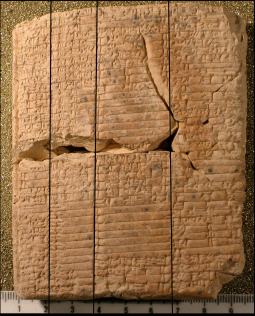Introduction to Cuneiform Sign Lists
| In order to display properly, this page needs the CuneiformComposite Unicode font by Michael Everson. The font may be downloaded here. |
Ancient sign lists document, teach, and preserve the correct usage of cuneiform signs, particularly for writing Sumerian. Cuneiform was invented in the late fourth millennium in the deep south of what is now Iraq. It was initially used for writing Sumerian, a linguistic isolate which was spoken in Southern Babylonia until about 2,000 BCE, and which continued to be used as a language of scholarship and religion until the beginning of the first millennium C.E.. In the middle of the third millennium, the writing system was adapted for writing Akkadian, a Semitic language in use in approximately the same area.
Cuneiform uses word signs (logograms) and syllable signs (phonograms), using between 600 and 900 individual sign forms; the number fluctuates due to mergers and splits. Most signs may be used to write multiple words and/or multiple syllables. A trained scribe (or modern Assyriologist) can tell which word or syllable is meant by context. Akkadian and Sumerian use the same inventory of signs, but the proper use of those signs differs considerably between the two languages.
| Gloss | Sign Form | Sign Name | Akkadian | English |
|---|---|---|---|---|
| ge-e | 𒈪 | gi-ik-ki-gu | mu-šu | night |
| ku-u₂ | 𒈪 | gi-ik-ki-gu | ek-le-tu | darkness |
| gi-ig | 𒈪 | gi-ik-ki-gu | ṣal-mu | black |
| ṣul-mu | blackness | |||
| du-gu-ud | 𒂂 | du-gu-ud-du | ka-ab-tu | heavy |
Sign lists provide five types of data: pronunciation gloss, sign form, sign name, (Akkadian) translation(s) and (Sumerian) lemma. Each of these data types will be discussed in brief.
Gloss. Pronunciation glosses provide information about the phonological shape of a Sumerian word by spelling it using syllabic signs. The example passage has three different glosses for the sign MI (𒈪) and one for the sign DUGUD (𒂂). The three glosses (column 1) of MI correspond to three Sumerian words or lemmas (ĝi₆ "night"; ku₁₀ "dark/darkness"; and giggi "black"); each of them are translated into Akkadian in column 4.
Sign form. Sign lists are usually arranged by sign form. Similar signs are juxtaposed within the same section. This allows the user (ancient or modern) to observe subtle differences between signs. The example above shows how the section 𒈪 (MI) is immediately followed by the sign 𒂂 (DUGUD), which differs only by adding one extra wedge at the end, but means something entirely different.

MS 1811 (M. Civil: CUSAS 12, 1.1.1). Sign list Ea in four columns: Gloss, Sign, Sign Name, and (Akkadian) translation.
Sign Name. Sign names are comparable to the names of the letters of our alphabet, standard ways of referring to a particular character. These ancient sign names are derived from one common reading of that sign. Thus the sign 𒈪 (MI) in the example above is called gikkigu (derived from the reading giggi "black"), and the sign 𒂂 (DUGUD) is called dugudu. Although many sign lists omit sign names, there are still an estimated 2,500 such names have been preserved. Sign names will be collected in a separate Sign Name glossary.
Translation. The Akkadian translation provides a meaning of the Sumerian word or words that are written (logographically) by the sign in question. In the example above the first two entries receive one translation each, the third entry has two ("black" or "blackness"). Occasionally, sign lists may provide up to seventy different translations of a single Sumerian word. Akkadian words found in the signlists are available in the Akkadian glossary.
Lemma.In addition to the four explicit data types, we provide a fifth, the Sumerian lemma that is referenced by the entry as a whole. The lemmas in the example above are ĝi[night]; kukku[dark]; giggi[black]; and dugud[heavy]. In the editions, the lemma is given to the far left: [[ĝi₆]]. Each entry will be annotated in order to link the entry to the appropriate lemma in the electronic Pennsylvania Sumerian Dictionary; the lemmas are harvested in the Sumerian glossary.
Each of the data types discussed above is important for the modern decipherment of cuneiform (in particular Sumerian), but also for the history of ancient scholarship and education.
The majority of cuneiform sign lists may be assigned to one of five "families" of related compositions. These are traditionally referred to as:
- Ea
- Diri
- Syllabary A
- Syllabary B
- Idu
Each of these sign list families have their own character and history, described in detail in their respective pages.
27 Dec 2019C. Jay Crisostomo
C. Jay Crisostomo, 'Introduction to Cuneiform Sign Lists', Digital Corpus of Cuneiform Lexical Texts: Sign Lists, The DCCLT Project, 2019 [http://oracc.museum.upenn.edu/dcclt/signlists/signlists/]
